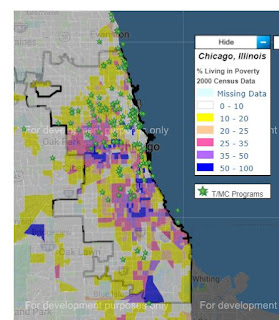However, the map of Chicago has changed dramatically over the past 40 years, making this goal much more difficult.
Below is are two maps from a WBEZ article titled "The Middle Class is Shrinking Everywhere. In Chicago, It's Almost Gone."
 |
| read WBEZ article |
You can see a dramatic change in Chicago demographics, creating two Chicagos, one rich, and one poor, with few in the middle. I've been trying to bridge these divides by helping youth tutor/mentor programs grow in different parts of Chicago. It's been difficult.
At the left is my map showing non-school tutor and/or mentor programs in Chicago. I circled areas of very high income, showing that there are many youth programs in this area, or on the fringes.
You can view this map on the MappingforJustice blog, along with many other articles showing uses of maps. The article also includes a link to my list of Chicago area tutor/mentor programs.
If you look at some of my Tweets @tutormentorteam, and articles I've posted in the past few weeks, you can see how I work to keep this list updated, and how I try to draw attention to programs. You'll also see a concern that some programs are very well organized with a lot of information on their web sites, while others have less formal organization and less information on the web site.
Below is a graphic I've used for 20 years to visualize the design of a mentor-rich youth program, with volunteers from different work and college backgrounds sharing their experiences and opening doors to career opportunities for kids who don't have many people living near them who model these experiences.
 |
| View Total Quality Mentoring PDF |
 |
| view video |
Another version can be seen here.
With the changing demographics, concentrating high income people along the Northeast lakefront of Chicago, and dramatically reducing the middle class, how will we create places for youth and volunteers to connect in the types of organized, on-going, programs that build trust, relationships, empathy and understanding?
eMentoring programs are emerging as a way to make connections between volunteers who don't live in poverty areas and with youth who do. I point to a few in this section of the Tutor/Mentor library. I'm not yet confident in the ability of these programs to build the depth of relationship that is possible from meeting face to face two to three times every month.
One reason I'm concerned is shown by another WBEZ map, which shows the Digital Divide in Chicago. If kids don't have a place to access the internet, how can they form regular relationships with eMentors? Maybe using phones?
I've collected some Digital Divide articles on this site.
Unless more people become motivated to dig into these articles, or read my blog, those articles will be seen by too few people. Too few will be involved in building solutions to these problems.
One of my frustrations is that I've not been able to maintain the interactive tutor/mentor program locator which the Tutor/Mentor Connection built between 2004 and 2008. At the right is a screen shot from the current version.
I show poverty levels, just like the WBEZ maps, with overlays that show locations of tutor/mentor programs, and other overlays that show indicators of need, such as poorly performing schools, and assets, such as businesses, faith groups, hospitals and universities, located in different parts of the city.
Unfortunately this has not been updated since 2010 so the demographics are from 2000 and other data is out of date. I keep looking for partners who would help update this and/or rebuild it, then use it in efforts to build connections between rich and poor in cities like Chicago.
Want to help? Connect with me on Twitter, Facebook and/or LinkedIN, and share my articles with others. That's one way. Start a conversation about other ways to help. That's another way.
Another is to send a small contribution to help me keep writing these stories and maintaining the web library.









No comments:
Post a Comment